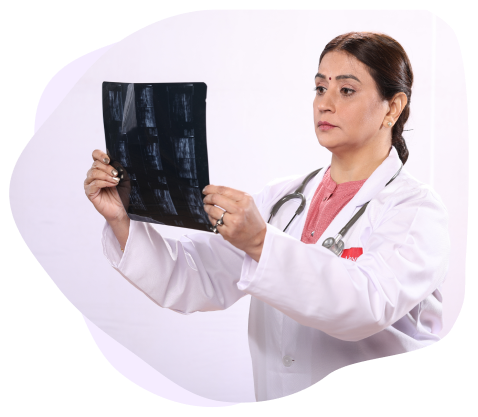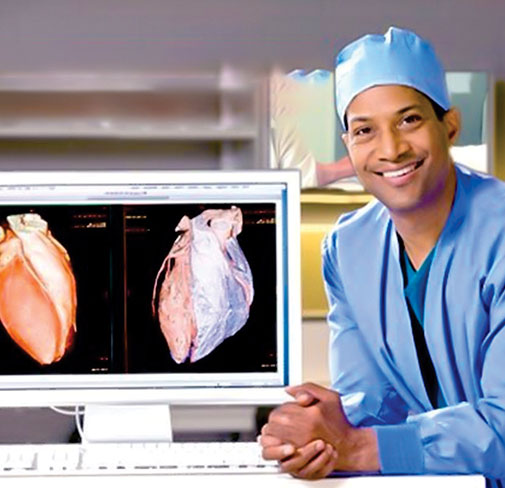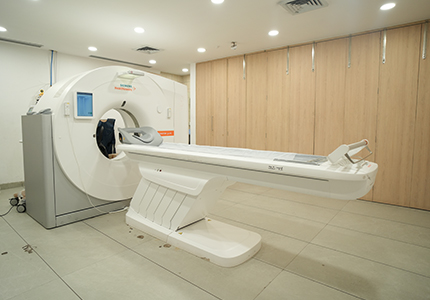
Radiology
Radiology, also known as diagnostic imaging, is a series of tests that take pictures of images of parts of the body. The field encompasses two areas - diagnostic radiology and interventional radiology.
A variety of imaging techniques such as Radiography, Ultrasonography, Computed Tomography (CT), Nuclear Medicine including Positron Emission Tomography (PET), Fluoroscopy, and Magnetic Resonance Imaging (MRI) are used to diagnose or treat diseases. Interventional radiology is the performance of usually minimally invasive medical procedures.
CT Angiography
The CT scanner makes it possible to non-invasively visualise arteries that carry blood to the brain (cerebral angio), heart (coronary angio), lungs (pulmonary angio), kidneys (renal angio), limbs (peripheral angio) etc. Advantages over regular Angiography:
- Non-invasive procedure
- Low radiation dose
- Independent of heart rate for cardiac Imaging
- No hospitalisation, No surgery, No pain or discomfort
- Clear images without the use of beta blocker, irrespective of heart rate
CT (computed tomography) angiography (CT-A) uses X-rays to visualise the inside of blood vessels as well as their walls. A radio-opaque fluid (contrast) injected into a vein mixes with blood and is tracked as it travels through various parts of the body. In the case of conventional cine-angiography a large tube (a catheter) is introduced into an artery so that contrast can be injected at the mouth of the blood vessel that needs to be examined. CT Angiography has been developed to avoid such an invasive procedure.


You should wear comfortable, loose-fitting clothing to your exam. You may be given a gown to wear during the procedure.
Metal objects including jewellery, eyeglasses, dentures and hairpins may affect the CT images and should be left at home or removed prior to your exam. You may also be asked to remove hearing aids and removable dental work.
You may need to fast for a few hours.
You may be asked not to eat or drink anything for several hours beforehand, especially if a contrast material will be used in your exam. You should inform your physician of any medications you are taking and if you have any allergies. If you have a known allergy to contrast material, or “dye,” your doctor may prescribe medications to reduce the risk of an allergic reaction.
Also inform your doctor of any recent illnesses or other medical conditions, and if you have a history of heart disease, asthma, diabetes, kidney disease or thyroid problems. Any of these conditions may increase the risk of an unusual adverse effect.
Women should always inform their physician and the CT technologist if there is any possibility that they are pregnant.
Frequently Asked Questions
Coronary artery disease affects blood vessels that supply nutrition to the heart muscle. It begins when, for some unknown reason, normal muscle cells in the wall of these blood vessels begin to multiply out of turn at one or more points. These cells grow and accumulate cholesterol from the blood resulting in a swelling on the inside of the blood vessel. It is this swelling that causes obstruction to the flow of blood. Sometimes a break in the covering of this swelling leads to the formation of a clot at that point. If the clot blocks the artery completely, a heart attack may result. Whenever the block remains incomplete (with or without clot) it usually produces chest pain commonly called “angina”. The disease usually develops slowly over a number of years and usually remains undetected for long. Only when clot formation occurs, or when there is a sudden increase in the size of the swelling, that sudden heart attacks strike. Such events are largely unpredictable.
CT (computed tomography) angiography (CT-A) uses X-rays to visualise the inside of blood vessels as well as their walls. A radio-opaque fluid (contrast) injected into a vein mixes with blood and is tracked as it travels through various parts of the body. In the case of conventional cine-angiography a large tube (a catheter) is introduced into an artery so that contrast can be injected at the mouth of the blood vessel that needs to be examined. CT Angiography has been developed to avoid such an invasive procedure.
CT technology uses several small detectors positioned in an arc around the patient. Each one of these detectors records a single X-ray image at a time. As the scanner frame spins around the patient, the detectors take snapshots of the fan-shaped beam of x-rays after it passes through the patient's body. Several hundred images are recorded in one turn of the detector. These are then analysed with the help of computer programs for appropriate display and analysis.
CT-A is a patient-friendly, non-invasive procedure that takes just a few seconds of recording though the total procedure time would be about an hour. Unlike conventional angiography the patient can go back to work immediately afterwards.
The CT equipment comprises a large circular unit, the scanner, mounted around a sliding table. Inside the frame of the scanner is a rotating device with two x-ray tubes mounted on one side and multiple detectors in an arc opposite it. It is this scanner that spins around the patient at high speed noiselessly.
The equipment at Atulaya Healthcare is the latest model comprising a dual source CT scanner which helps to improve image quality with faster and better imaging and without the need for controlling heart rate with drugs (beta-blockers) as is the case with other available CT equipment.
Most people feel a warm flush pass all over the body as the contrast material circulates. This lasts a few seconds only and subsides without any consequences. The only pain is at the time the cannula is inserted into an arm vein. It is important that you remain still during the examination.
CT exams are generally painless, fast and easy. With helical CT, the amount of time that the patient needs to lie still is reduced.
A team comprising a cardiologist and a radiologist will analyse the images and send a report to your doctor. Typically the results of CT-A are available within 24 hours, although in complicated cases special computer analysis may take somewhat longer.
As with conventional angiography, there is the risk of an allergic reaction (whenever contrast material containing iodine is injected into the body). Please do inform the technician about any history of allergy to X-ray dye before the test is initiated. CT-A is avoided in patients with kidney disease or severe diabetes as the x-ray contrast material can further harm kidney function.
Local leakage of contrast material at the site of injection can cause pain. If you feel any pain in this area during contrast injection, please inform any of the attending persons immediately. The procedure is not advised for pregnant women, especially during the first three months of pregnancy. Mothers who are breastfeeding at the time of the examination, should consider pumping out breast milk before the procedure for immediate use. Breast feeding can be resumed within a few hours by the time contrast material has usually left the body. Just like all of the other tests based on exposure to X-rays, there is a risk of cancer attributable to radiation exposure at CT-A. This risk has been considerably reduced with technological advances.
Coronary CT-A images may be fuzzy if the patient moves during the examination or if the heartbeat is irregular or the pumping function of the heart is very weak.
CT Vascular Angiography is a minimally Non invasive medical test that helps physicians diagnose and treat medical conditions. CT Vascular Angiography produces pictures of major blood vessels throughout the body.
In CT Vascular angiography (CTA), a contrast material (also known as “dye”) is injected into a vein to produce detailed images of both blood vessels and tissues.
In many ways CT scanning works very much like other x-ray examinations. X-rays are a form of radiation—like light or radio waves—that can be directed at the body. Different body parts absorb the x-rays in varying degrees.
In a conventional x-ray exam, a small burst of radiation is aimed at and passes through the body, recording an image on photographic film or a special image recording plate. Bones appear white on the x-ray; soft tissue shows up in shades of gray and air appears black. With CT scanning, numerous x-ray beams and a set of electronic x-ray detectors rotate around you, measuring the amount of radiation being absorbed throughout your body. At the same time, the examination table is moving through the scanner, so that the x-ray beam follows a spiral path. A special computer program processes this large volume of data to create two-dimensional cross-sectional images of your body, which are then displayed on a monitor. This technique is called helical or spiral CT.
CT imaging is sometimes compared to looking into a loaf of bread by cutting the loaf into thin slices. When the image slices are reassembled by computer software, the result is a very detailed multidimensional view of the body's interior.
Refinements in detector technology allow new CT scanners to obtain multiple slices in a single rotation. These scanners, called “multislice CT” or “multidetector CT,” allow thinner slices to be obtained in a shorter period of time, resulting in more detail and additional view capabilities.
Modern CT scanners are so fast that they can scan through large sections of the body in just a few seconds. Such speed is beneficial for all patients but especially children, the elderly and critically ill.
When a contrast material is introduced to the bloodstream during the procedure, it clearly defines the blood vessels being examined by making them appear bright white.
The technologist begins by positioning you on the CT examination table, usually lying flat on your back or possibly on your side or on your stomach. Straps and pillows may be used to help you maintain the correct position and to hold still during the exam.
A small amount of contrast material (“dye”) may initially be injected through the IV to determine how long it will take for the full amount to reach the area under examination. During scanning, the table will then move to the start point and then move relatively rapidly through the opening in the machine as the actual CT scanning is performed. An automatic injection machine connected to the IV is usually used and will inject contrast material at a controlled rate both prior to and during scanning. In some cases, especially in children, the injection is given by hand with a syringe by a person in the CT room, often a nurse.
Occasionally, sedation is needed for children to keep them still during the scanning. This usually needs to be pre arranged when the CT scan is scheduled as there will be special instructions. For example, eating and drinking must be stopped prior to the sedation procedure, and arrangements should be made for monitoring during recovery following the scan.
When the examination is completed, you will be asked to wait until the technologist verifies that the images are of high enough quality for accurate interpretation.

